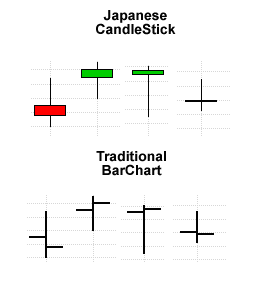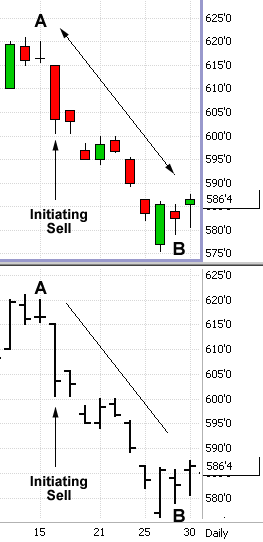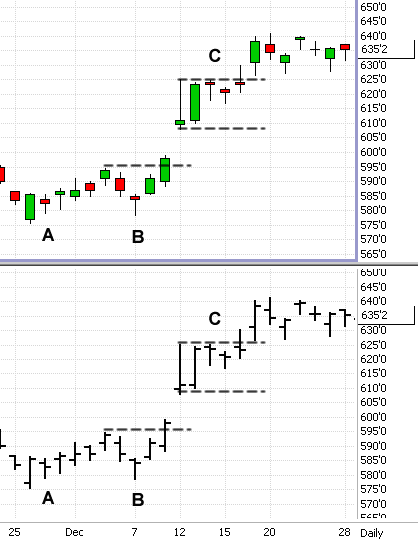Doji bars are one of the single most useful single bar patterns that any trader can identify. They can be used for entries, exits, or to determine position bias. “Doji” is a term used by Japanese candlestick chartists that refer to a bar where the open and close of a bar are in close approximation to each other. They do not have to be exactly the same, but they should be very close. For our purposes, we use the definition where the open and close are within 25% of the days trading range of each other. It doesn’t matter if the “Doji” occurs near the top, middle, or bottom of the days trading range, only that they are close. For example, if the days range (high to low) is 10 cents, then the open and close would need to be within 2 ½ cents of each other to qualify as a Doji.
The underlying theory of the Japanese Candlestick approach:
- The “what” a market is doing (price action) is more important than the “why” (news, market reports, and so on).
- All information known to the public is reflected in the current price.
- Buyers and sellers move markets based on expectations and emotions (fear and greed).
- Markets fluctuate and oscillate.
- The actual current price may not reflect the real underlying value.
But more importantly, what most Doji bars represent is indecision in the market place, a place in the market where neither buyers or sellers have an advantage over each other, nor are willing to commit to the market, and are at an impasse.
Position, Swing and Day Traders:
- For longer-term traders, dojis are often found at turning points where trends reverse, and they are almost always found in patterns of consolidation where it is indeterminate whether a trend will continue or reverse.
- For day traders, dojis can act as the catalyst for signal set-up bars that may indicate potential trend days.
Although the term doji refers to Japanese candlestick charts, you do not actually need to look at a Candlestick chart to recognize dojis; in fact, they can be easily recognized on conventional bar charts. There is one significant difference between candlesticks and the conventional bar chart. Candlesticks tend to highlight the Open-to-Close relationships where as traditional bar charts tend to highlight a Close-to-Close relationship. With a little practice, Doji bars are easily identifiable when looking at a traditional bar chart. In the illustrations you will be looking at, a red “body” will highlight a “Down” bar (where the close is below the open), and Green will highlight an “Up” bar (where the close is higher than the open). Standard black will be used for the traditional bar charts.
Here is an example of Doji bars plotted both ways-Japanese candlestick style versus the traditional bar chart method.
Any trades are educational examples only. They do not include commissions and fees.

Now let’s take a look at a few examples with both Japanese candlesticks and the traditional bar chart together and discuss how to practically incorporate the “Doji” bars into our trading approach. The featured market here will be Soybeans. There are several points of interest in Chart #1.
Chart 1

First, the obvious point is that Doji bars occurred at both ends of the downtrend, beginning at point “A” and ending at point “B”. The second, and most important, point is that even though Doji bars occur at both ends of this short trend, they did not forecast the trend or the reversal. What they did do was provide the “Heads-Up” that the previous price action in the market was changing and the market might merit a trader’s attention. One of the largest problems a speculator faces is learning “where” to focus his or her attention and funds. Learning to identify and trade Doji bars can help make these decisions.
Note that while the Doji at point “A” gave the heads up, the trend was not initiated until the bar labeled “Initiating Sell” was established. After the short downtrend, notice that at point “B” we see 2 Doji bars back-to-back. At this time there is no way to know whether the trend is pausing before resuming the move lower or whether the trend will reverse.
In most successful trades there is a point when markets are cooperating and the trader feels secure with his or her position, then at some point the picture becomes “muddled” and uncertain. Learning to identify and properly react to Doji bars can help a trader deal with this period of uncertainty.
Any trades are educational examples only. They do not include commissions and fees.
Now let’s see what happens next in Chart # 2.
Chart 2

Here we pick up where we left off in the first example. As you can see at point “A” there was a moderate rally after the previous downtrend. Although the market moved higher, this is hardly what could be called a reversal. Again we would like to emphasize that a Doji bar is not predictive of future price direction, only that the previous environment has changed. Market bias, entry/exit signals, and positions should still be determined by additional analysis.
At point “B” we can see another “Doji” bar on the 2-day break from the recent high. It might be appropriate to expect a move to the upside but it would only be a suspicion. The potential trend reversal was not complete until new highs were made, in particular a close above the previous swing high marked by the dotted horizontal line.
Moving forward, we can see that the area marked by point “C” begins a consolidation phase that last for 5 days. It is important to note that in this case the Doji bar(s) did not result in a trend reversal but rather defined a trading range and a period of consolidation before the trend resumed the move to the upside.
Markets are in a constant state of flux going from trending to consolidation to trending again, either by reversing or continuing the previous trend. Learning to identify, understand, and react to Doji bars can help a trader identify where a market is in the cycle and trade accordingly.



